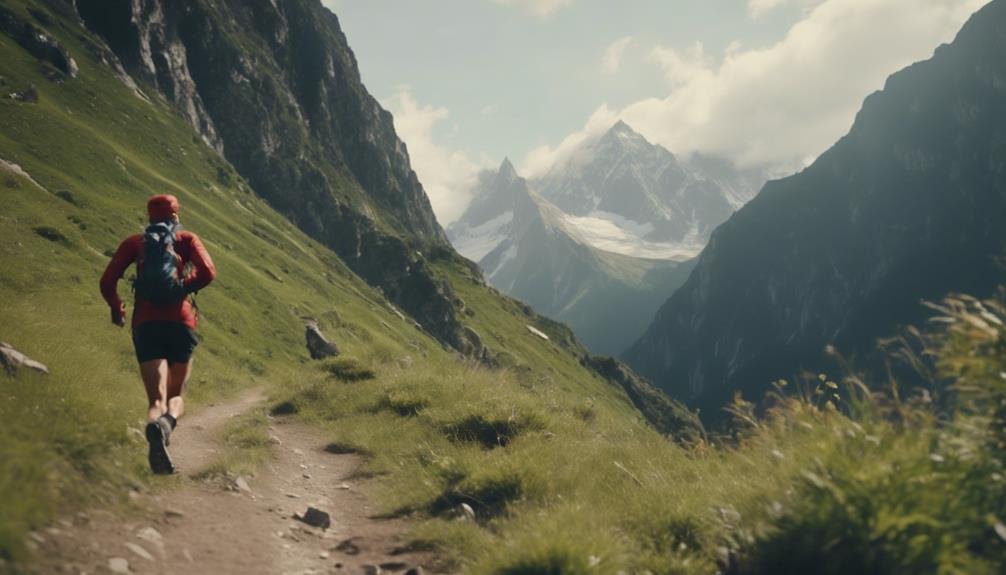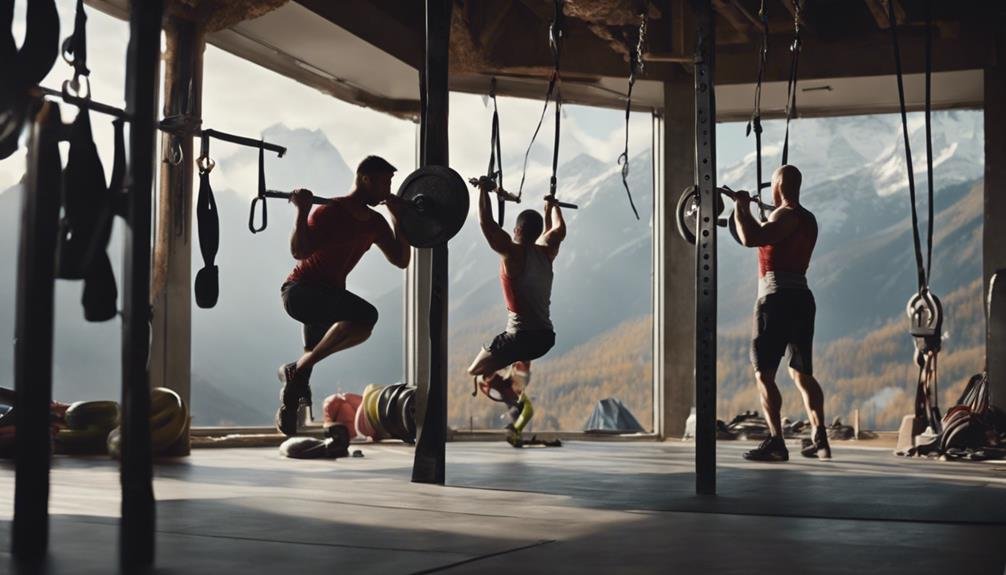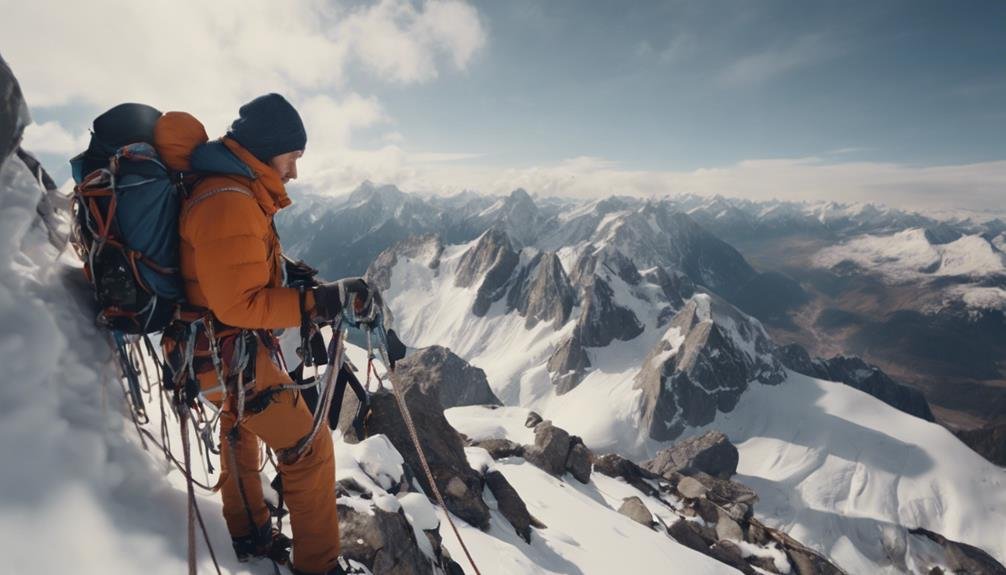
To train for a mountaineering expedition, I've assessed my current fitness level first. Building aerobic endurance through hiking and trail running is key. I incorporate strength training, focusing on core stability and compound movements. Flexibility and mobility work, like yoga and foam rolling, help prepare my body. Nutrition is vital, so I fuel up with balanced meals packed with carbs and proteins. Additionally, I mentally prepare by practicing mindfulness and setting realistic goals. By following this structured approach, I feel ready to tackle any peak. If I keep pushing and refining my strategy, I'll discover even more effective techniques.
Key Takeaways
- Assess your current fitness level through body composition tests and establish a cardio baseline to track progress effectively.
- Build aerobic endurance with activities like hiking, trail running, and circuit training that combine strength and cardio exercises.
- Incorporate strength training focusing on compound movements and core stability, aiming for 3-4 sessions per week to enhance physical preparedness.
- Prioritize flexibility and mobility through yoga, foam rolling, and dynamic warm-ups to maintain joint health and reduce injury risk.
Assess Your Current Fitness Level

Before diving into a rigorous training regimen, I need to honestly evaluate my current fitness level to identify areas that require improvement. The first step is conducting a body composition assessment. This helps me understand my muscle and fat ratios, giving me a clearer picture of where I stand. Knowing my body composition not only sets the stage for my goals but also motivates me to push beyond my limits.
Next, I establish my cardio exercise baseline. I start with a simple test, like a timed mile run or a 20-minute brisk walk, to gauge my endurance. This baseline serves as a reference point for measuring my progress over time. It's essential to track any improvements to stay motivated and engaged in the process.
Build Aerobic Endurance

To build my aerobic endurance, I focus on cardio workouts that get my heart pumping and improve my stamina.
Incorporating activities like hiking and trail running not only enhances my fitness but also prepares me for the challenges of mountaineering.
I've found that consistent effort in these areas makes all the difference during long climbs.
Cardio Workouts Essential
Building aerobic endurance is crucial for any mountaineering expedition, as it directly impacts my ability to tackle long climbs and recover quickly between challenging ascents. To achieve this, I focus on a mix of cardio workouts, including circuit training and weight-based exercises.
Circuit training keeps my heart rate up while building strength. I create circuits that combine bodyweight exercises like burpees and jump squats with short bursts of cardio, like jumping rope or running in place. This variety not only boosts my endurance but also keeps my workouts exciting and engaging.
Incorporating weight-based exercises, such as deadlifts and squats, helps me develop the strength needed for carrying a heavy pack over rough terrain. I aim for higher reps with moderate weights to enhance my stamina, ensuring that I'm not just strong but also capable of sustaining that strength over time.
Ultimately, blending these workouts into a well-rounded routine empowers me to face the peaks with confidence. The freedom to explore the mountains awaits, and with every heartbeat, I'm one step closer to conquering them. Embrace the grind—it's all part of the adventure!
Hiking and Trail Running
Hiking and trail running are fantastic ways to boost my aerobic endurance while immersing myself in nature's beauty. These activities not only strengthen my cardiovascular system but also offer a sense of freedom that invigorates my spirit.
To make the most of my hikes and runs, I focus on varying terrain conditions, which helps me adapt and grow stronger.
Choose diverse trails: Different terrain conditions challenge my body in unique ways.
Practice navigation strategies: Getting lost isn't an option; using maps and GPS keeps my mind sharp.
Set achievable goals: I aim for distance, elevation, or time to track my progress.
Listen to my body: I pay attention to signs of fatigue to avoid injury and burnout.
Enjoy the journey: I embrace the natural beauty around me, making every outing rewarding.
Strength Training Essentials

Strength training is crucial for enhancing my endurance and power on the rugged slopes of a mountaineering expedition. To conquer those peaks, I focus on core strengthening exercises and weight training techniques that build the muscle I need. A strong core stabilizes my body as I navigate challenging terrain, while proper weight training enhances my overall strength, helping me carry my gear with ease.
I incorporate exercises like deadlifts and squats, which target major muscle groups and mimic the physical demands of climbing. These compound movements not only boost my strength but also improve my balance and coordination. I also prioritize core workouts, such as planks and Russian twists, which ensure that my abdominal muscles can withstand the rigors of mountaineering.
Setting a consistent schedule is key. I aim for three to four sessions a week, gradually increasing the weights and intensity to push my limits. This approach not only prepares my body but also empowers my mind, instilling confidence as I prepare for the adventure ahead. With dedication and the right strength training essentials, I know I'll be ready to embrace the freedom of the mountains.
Flexibility and Mobility Work

To complement my strength training, I focus on flexibility and mobility work, which enhances my range of motion and helps prevent injuries while tackling challenging climbs. I've found that incorporating these practices into my routine not only boosts my performance but also keeps me feeling free and agile in the mountains.
Foam rolling techniques: I use a foam roller to release tight muscles and improve blood flow. It's a game changer for recovery.
Static stretching practices: After my workouts, I dedicate time to static stretches, targeting major muscle groups to enhance flexibility.
Dynamic warm-ups: Before climbing, I engage in dynamic movements that prepare my body for the demands ahead.
Yoga sessions: I incorporate yoga to improve both flexibility and mental focus, helping me stay centered during my expeditions.
Regular mobility drills: I include specific drills to maintain joint health and ensure my body moves freely.
Hiking and Trail Running

Exploring the trails through hiking and trail running not only builds my endurance but also strengthens my connection to nature, fueling my passion for mountaineering. I've found that varying my terrain selection is crucial for a well-rounded fitness routine. I often seek out diverse landscapes—rocky paths, steep hills, and even soft forest trails—to mimic the conditions I'll face on my expedition.
To stay consistent, I've developed a training schedule that incorporates both hiking and trail running. On weekends, I tackle longer hikes to improve my stamina, while weekday sessions focus on shorter, faster-paced runs. This combination helps enhance my cardiovascular fitness while also building leg strength, which is essential for tackling challenging ascents.
I keep track of my progress, adjusting my schedule as needed based on how my body feels. Embracing the freedom of the outdoors keeps my motivation high, reminding me why I'm training in the first place. By committing to this routine, I'm not only preparing my body for the peaks but also deepening my appreciation for the breathtaking landscapes that await me.
High-Altitude Acclimatization

When it comes to high-altitude climbing, acclimatization is crucial for my success and safety.
By focusing on these key strategies, I can tackle the challenges of altitude with confidence.
I've learned that taking gradual elevation gains, along with proper hydration and nutrition, can make a significant difference in how my body adjusts.
Importance of Acclimatization
Acclimatization is crucial for our bodies to adapt to high altitudes, ensuring we can tackle the challenges of a mountaineering expedition safely and effectively. Without proper acclimatization, we risk altitude sickness, which can put a damper on our adventure.
Know your limits: Listen to your body and recognize signs of altitude sickness.
Proper pacing techniques: Don't rush; take it slow to allow your body to adjust.
Stay hydrated: Drink plenty of fluids to support your body's physiological changes.
Nutrition matters: Fuel your body with energy-rich foods to keep your strength up.
Rest and recovery: Allow time for rest days at higher altitudes to adapt properly.
Gradual Elevation Gain
Gaining elevation gradually is essential for allowing my body to adjust effectively to the challenges of high-altitude environments. I've learned that a well-planned ascent can make all the difference in how I feel and perform during my expedition. By employing proper pacing techniques, I can manage my energy levels and reduce the risk of altitude sickness, which is crucial when I'm venturing into the unknown.
Starting with lower altitudes, I focus on a gradual mileage increase, giving my body time to adapt to the thinning air. Each step upwards is a step towards freedom, as I embrace the beauty of nature and the thrill of the climb.
I like to map out my hikes, incorporating rest days and shorter trips at higher elevations to allow for recovery and acclimatization. I also pay attention to my breathing and heart rate, ensuring I'm not pushing too hard too soon.
This gradual approach not only enhances my physical endurance but also builds my confidence as I tackle new heights. Ultimately, it's about enjoying the journey while preparing myself for the majestic peaks ahead.
Hydration and Nutrition Tips
Staying properly hydrated and nourished is just as important as gradual elevation gain for ensuring my body adapts effectively to high-altitude challenges. As I venture into the peaks, I focus on maintaining my electrolyte balance and optimizing my calorie intake.
Drink Water Regularly: I aim for at least 3-4 liters daily to combat altitude dehydration.
Electrolyte Drinks: I include electrolyte-infused beverages to replenish lost minerals during my treks.
High-Calorie Snacks: I pack energy-dense foods like nuts, energy bars, and dried fruits to keep my energy levels up.
Balanced Meals: I prioritize meals rich in carbohydrates, healthy fats, and proteins to fuel my body efficiently.
Listen to My Body: I stay attuned to how I'm feeling, adjusting my intake based on energy expenditure and altitude effects.
Embracing these nutrition and hydration strategies not only empowers me but also allows me to savor the freedom of the mountains. By keeping my body fueled and hydrated, I set myself up for success, ready to conquer whatever challenges lie ahead.
Nutrition for Peak Performance

To fuel my body for the rigors of mountaineering, I focus on a balanced diet rich in carbohydrates, proteins, and healthy fats that supports both endurance and strength. I know that proper nutrition not only powers my climbs but also enhances my sleep quality, allowing me to recover effectively. Meeting my protein requirements is essential; it helps rebuild muscles and keeps me energized for the challenges ahead.
Here's how I break down my daily nutrition:
| Meal Type | Key Components | Example Foods |
|---|---|---|
| Breakfast | Complex Carbs, Protein | Oatmeal with nuts |
| Lunch | Lean Protein, Vegetables | Grilled chicken salad |
| Snack | Healthy Fats, Simple Carbs | Almonds and dried fruit |
| Dinner | Protein, Whole Grains | Salmon with quinoa |
| Pre-Bed Snack | Cottage Cheese, Berries | Greek yogurt with fruit |
Mental Preparation Techniques

Visualizing my success on the mountain not only boosts my confidence but also sharpens my focus, preparing me mentally for the challenges ahead. To thrive in the great outdoors, I've embraced several mental preparation techniques that keep me grounded and ready for anything.
Practice mindfulness training: Staying present helps me manage anxiety and enhances my decision-making.
Develop goal setting strategies: I break down my ultimate goal into smaller, manageable milestones, making the journey feel less daunting.
Visualize challenges: I imagine potential obstacles and rehearse how I'll overcome them, building resilience in my mind.
Cultivate a positive mindset: I replace negative thoughts with affirmations, creating a mental environment conducive to success.
Reflect on past experiences: I draw strength from previous climbs, reminding myself of my capabilities and growth.
With these techniques, I feel mentally agile and ready to embrace the freedom and thrill of mountaineering. By investing in my mental preparation, I not only enhance my performance but also deepen my connection to the mountains, making every ascent a liberating experience.
Gear and Equipment Familiarization

I've realized that understanding my gear is just as important as physical training for my mountaineering expedition.
I'll go through my essential gear checklist and learn the proper handling techniques to ensure I'm fully prepared.
This familiarity not only boosts my confidence but also enhances my safety on the mountain.
Essential Gear Checklist
Having the right gear is crucial for a successful mountaineering expedition, so let's dive into the essential items you'll need to familiarize yourself with. The right equipment not only keeps you safe but also empowers you to fully embrace the freedom of the peaks.
Understanding layering techniques is key; it helps you stay warm and dry in unpredictable weather. Cold weather clothing is your first line of defense against the elements.
- Base Layers: Moisture-wicking shirts and long underwear for comfort.
- Insulating Layers: Fleece or down jackets to trap heat.
- Outer Shell: Waterproof and windproof jackets to shield against the elements.
- Footwear: Sturdy, insulated hiking boots with good grip for varying terrains.
Equipment Handling Techniques
How can mastering equipment handling techniques enhance my confidence and efficiency during a mountaineering expedition? When I take the time to learn proper rope handling techniques and knot tying skills, I feel empowered to tackle any challenge the mountains throw at me. Knowing how to manage my gear effectively not only boosts my confidence but also ensures that I'm prepared for unexpected situations.
I always start by practicing basic knot tying skills, like the figure-eight and bowline. These knots are essential for securing myself and my gear, and mastering them provides me peace of mind.
Next, I focus on rope handling techniques—learning how to coil, throw, and manage rope effectively saves me time and energy on the climb.
I also simulate real-life scenarios, like setting up a belay or rappelling down a cliff, to reinforce my skills. Each practice session allows me to familiarize myself with my equipment, making me more efficient when it counts.
Ultimately, by honing these skills, I'm not just preparing for an expedition; I'm embracing the freedom that comes with being self-reliant in the wild.
Monitoring Progress and Adjustments
Monitoring my progress during training is crucial for making timely adjustments that enhance my performance and readiness for the expedition. Without a clear view of where I stand, I can't effectively implement adjustment strategies to improve my skills and endurance. I track my workouts, nutrition, and recovery to ensure I'm on the right path.
Set measurable goals: I define specific milestones to achieve, making it easier to track my improvement.
Keep a training log: Recording my workouts helps me identify patterns and areas needing attention.
Regularly assess fitness levels: I schedule fitness tests every few weeks to gauge my stamina and strength.
Listen to my body: I stay in tune with how I feel and adjust intensity accordingly to avoid burnout.
Seek feedback: I connect with fellow climbers and trainers for external perspectives on my progress.
Conclusion
In conclusion, training for a mountaineering expedition is an exciting journey that requires dedication and preparation.
By focusing on your fitness level, strength, and mental resilience, you'll not only enjoy the climb but also feel empowered by your progress.
Did you know that just a 10% increase in your aerobic capacity can significantly improve your endurance on the trail?
So lace up those boots, stay committed, and get ready to conquer those peaks!
